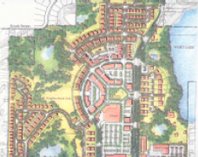Briggs Urban Village

I am interested to see what happens with the Briggs Urban Village. The 810-home development will have a grocery store, and a cute little pretend "downtown" area, and a 6-acre preserved nature area along Ward lake. (Does this mean the public will finally be able to swim there again? It used to be such a great swimming spot.)
Also, I am wondering what will happen to the Chambers Prairie Grange in all of this. Its been shut down for a while and is in need of fixing up, but it is a great grange with a kitchen and dance floor. I've been wondering if anyone was going to buy it and make it into something cool.
I must admit, I wanted to hate the idea of the Briggs village just out of principle. I mean, how can housing developments be a good thing? But I looked at the Briggs website and the plans are far superior to regular housing tracts.
Condominiums, duplexes, townhouses, and single family homes are all included, with preserved "open spaces", an old-fashioned, commmon sense idea that is now considered revolutionary and new.
There will be no apartments or affordable homes. Everything there will be exorbitantly expensive. In fact, those of us who are renters and not yet rich should probably just leave the county now, as we will probably never be able to buy in our hometown. However, it will not be gated, and the developer said, rather ironically, "This is a welcoming community."
Here is what I don't understand: why is the city in support of development of new mixed-use neighborhoods when our existing neighborhoods have zoning that makes commercial development and higher density housing so difficult to create? Is the council looking into changing our residential zoning? They should.
I really hope this place doesn't end up looking like Disneyland. Like New York City: its a nice place to visit, but I wouldn't want to live there.

5 Comments:
In some ways the Briggs Urban Village is doing the right thing, albeit on a small scale. The people that design these projects are coming to realize that a housing project needs a center, a place for people to gather. Commerce is usually the force that creates that gathering place, but in need not be commerce in particular.
The new housing projects may be trying to turn back time to an era where the downtown was the focus of a town. I guess this is all good, maybe it will be a plastic downtown, but it will serve the intended purpose.
As you observed, this type of neighborhood commercial activity has pretty much been zoned out during the last 50 years. I hope that our city planners take a page out of Briggs' book and look towards our existing neighborhoods and downtowns. A project like Urban Layers is a step in the right direction, but there are other steps that can be taken.
Crenshaw Sepulveda
I drove by the construction site yesterday. It look like its going to be really ugly.
They built a very similar community in Denver when I lived out there. It is on what was once the old airport. Briggs looks like a page out of the New Urbanist textbook. I'm not against that, I think it is a step in the right direction. Stapelton had a little bit of a disney feel to it, but overall it really was a walkable, interesting community with convenient shopping, etc. It also turned out to be very diverse. They had a lot of lower income housing spread throughout the development and it was as attractive as any other home there.
I agree that it the city should take a hard look at current zoning. It's amazing that the goal used to be to encourage strip malls.
I guess, while on the right track, BUV remains a commercial project for the benefit of the investors in the project. The "concept" may be new but the execution is strictly for the benefit of the investors. No doubt there will be a village square with a Starbucks, McDonalds mini, and possibly an Applebys for "eatin' good in the neighborhood".
We already have many models for real versions of the BUV, but they haven't done anything like this for more than 50 years. Of course, 50 years ago this wasn't a "planned" thing, it was an organic thing that made sense for a community. Homes sprung up around central business areas. Indeed the central business areas actually provided some housing as well. A symbiotic realationship existed between the business and and the residential area that surrounded it. Residential supported commerce and commerce provided a source of local employment for the residental. I suspect a car in this type arrangement was rarely needed.
A true commercial/residental district has far more benefits than I can describe right now. I can only say that if are to recreate what was ordinary some 50 years ago we will have to do it outside the normal investor based developments. They might have a certain surface appeal, but they will fall way short of the social dividends they pay. Artifical communities are just that....artificial.
If you only knew the inside scoop on this project and how few dollars the investors are really standing to make. I have pretty good information on this and it's looking like it will be difficult to show a profit when all is said and done. Although paper losses are not necessarily true losses so you may be correct that the "investors" are "banking" on the commercial center for revenue.
Post a Comment
<< Home